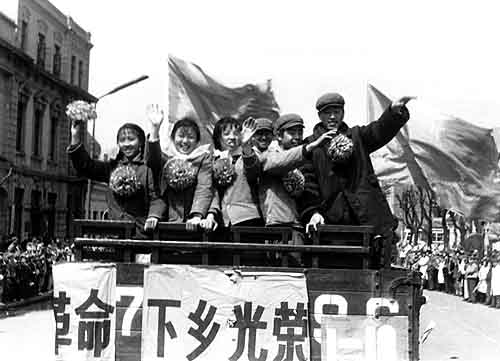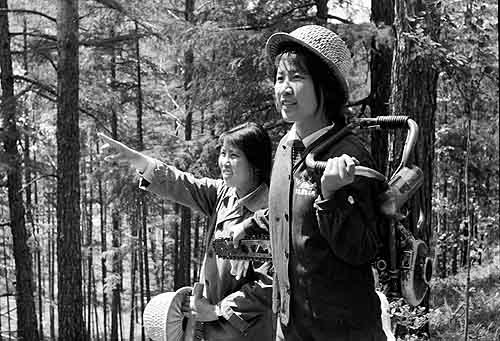|
 |
|
FAREWELL TO CITIES: A group of "educated youth" leaves home to work in the countryside in 1973 |
The image of millions of young people trekking from the cities to the countryside to work alongside farmers in the fields is an enduring part of the chapter of China's history.
Known as zhiqing, or "educated youth," these young people were a mixture of those who volunteered to go to work and those who were forced to go there during the "cultural revolution" (1966-76).
Under a directive from Mao Zedong, then leader of China, the movement of "going to mountain areas and the countryside" set off on December 12, 1968.
In March 2009, the book History of Chinese Zhiqing was revised and republished after its first publication 11 years ago.
 |
|
WORKING GIRLS: Members of an "educated youth" tree-cutting team work in a forest in China's northeastern region in 1970 |
Containing two volumes—First Waves, which tells the history of the movement between 1953 and 1968, and Big Tide, which covers the period from 1966 to 1980, the book records the whole course of this social phenomenon that spanned more than 20 years and involved around 17 million young Chinese.
Ironically, although zhiqing referred to young people with knowledge. The vast majority of those who migrated had only received elementary to high school education, and only a small portion of them had the opportunity to have studied at a university.
Clouded history
The authors of the book are Ding Yizhuang and Liu Xiaomeng, who were actually among the army of "educated youth" and are now renowned scholars at the Chinese Academy of Social Sciences.
They said it is regretful that few Chinese today know much about the history of that period—and that includes the millions directly involved and their families.
"This period of history was a heavy one in the process of human evolution and by being ignorant of it we will pay the price some day in the future," Liu said in an interview with the Beijing-based Oriental Outlook magazine. "What we can do is to disclose the truth of history."
Both authors said that the root of the movement resided in the economic contradiction of China at that time. The unemployment pressure in the cities was the basic driving force behind the movement. Partly caused by the population expansion, the increasing unemployment interwove with other problems occurring in the labor management system, economic system and economic structure of China since the middle of the 1950s.
In 1956, the socialist transformation in China had been basically completed, and the urban areas of the country carried out a single state-owned economy. Former private businesses, small-scale handicraft workshops and the service industry that formerly could provide a good number of jobs became public-owned bodies, state-owned institutions or enterprises, whose capability to absorb labor was limited. Thus, more and more young people in cities found it difficult to find jobs after graduation.
At the same time, after the agricultural cooperative movement was launched in the rural areas, the problem of surplus rural labor became more prominent throughout the country.
The Central Government therefore adopted two measures: one was limiting the rural population from pouring into cities through strict regulations on the registered permanent residence system, the other was moving urban residents to the countryside on a large scale, making the rural areas a reservoir of urban surplus labor.
"Although the root of the movement was the economic pressure, the political enforcement and push increased the graveness of the matter," Ding said. As a result, a total of 17 million urban youth participated in the movement, she said.
Differing views
Ding and Liu severely oppose the opinion held by some people today that the original intention of the movement was right, and only because of the manipulation by the Gang of Four, the ultra-leftists who held the top leadership during the "cultural revolution," did the movement deviate from its original intention.
"A general law of the development of human society is that no matter in which country, economic development, especially when accompanied by agricultural and industrial modernization, will inevitably lead to the transfer of rural surplus labor to non-agricultural sectors and the urbanization of the rural population," Liu writes in the book, "while the movement in China did exactly the opposite, trying to turn the large group of educated urban youth to be farmers."
| 